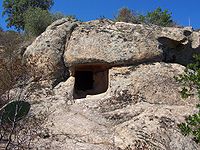
Domus de Janas
Encyclopedia

Chamber tomb
A chamber tomb is a tomb for burial used in many different cultures. In the case of individual burials, the chamber is thought to signify a higher status for the interree than a simple grave. Built from rock or sometimes wood, the chambers could also serve as places for storage of the dead from one...
s found in the Mediterranean area, but typically in Sardinia
Sardinia
Sardinia is the second-largest island in the Mediterranean Sea . It is an autonomous region of Italy, and the nearest land masses are the French island of Corsica, the Italian Peninsula, Sicily, Tunisia and the Spanish Balearic Islands.The name Sardinia is from the pre-Roman noun *sard[],...
. They consist of several chambers quarried out by the Ozieri
Ozieri culture
The Ozieri culture was a prehistoric pre-Nuragic culture that lived in Sardinia from c. 3200 to 2800 BC. It takes its name from the locality where the main findings connected with it have been found, the grotto of San Michele near Ozieri, in northern Sardinia...
and Beaker cultures, resembling houses in their layout.
Built between 3400 and 2700 BC, more than 1000 of the rock-cut tombs are known on the island. They date to the Chalcolithic and Bronze Age
Bronze Age
The Bronze Age is a period characterized by the use of copper and its alloy bronze as the chief hard materials in the manufacture of some implements and weapons. Chronologically, it stands between the Stone Age and Iron Age...
. A necropolis of them at the site of Anghelu Ruju, near Alghero
Alghero
Alghero , is a town of about 44,000 inhabitants in Italy. It lies in the province of Sassari in northwestern Sardinia, next to the sea.-History:The area of today's Alghero has been settled since pre-historic times...
, consists of 36 tombs some carved with bulls' heads. Another large site is that of Sant'Andrea Priu at Bonorva
Bonorva
Bonorva is a comune in the Province of Sassari in the Italian region Sardinia, located about 140 km north of Cagliari and about 40 km southeast of Sassari....
, including 18 chambers: during the late Roman and Byzantine
Byzantine
Byzantine usually refers to the Roman Empire during the Middle Ages.Byzantine may also refer to:* A citizen of the Byzantine Empire, or native Greek during the Middle Ages...
dominations it was turned into a cave church. Other sites can be found at Pimentel
Pimentel
Pimentel is a comune in the Province of Cagliari in the Italian region Sardinia, located about 30 km north of Cagliari. As of 31 December 2004, it had a population of 1,200 and an area of 15.0 km²....
, Sedini
Sedini
Sedini is a comune in the Province of Sassari in the Italian region Sardinia, located about 180 km north of Cagliari and about 25 km northeast of Sassari. It is part of the Anglona traditional subregion....
, Villaperuccio
Villaperuccio
Villaperuccio is a comune in the Province of Carbonia-Iglesias in the Italian region Sardinia, located about 40 km southwest of Cagliari and about 13 km southeast of Carbonia, in the lower Sulcis....
, Ittiri
Ittiri
Ittiri is a comune in the Province of Sassari in the Italian region Sardinia, located about 160 km northwest of Cagliari and about 15 km south of Sassari. It is part of the Logudoro traditional region.-Main sights:...
and Porto Torres
Porto Torres
Porto Torres is a comune and city in northern Sardinia, in the Province of Sassari.It is situated on the north coast about 25 km east of the Gorditanian promontory , and on the spacious bay of the Gulf of Asinara.-History:...
.
The shape of grottoes can vary from that of a rounded hut with conical or triangular ceiling. The walls are often decorated with magical reliefs. The corpses, painted with red ochre
Ochre
Ochre is the term for both a golden-yellow or light yellow brown color and for a form of earth pigment which produces the color. The pigment can also be used to create a reddish tint known as "red ochre". The more rarely used terms "purple ochre" and "brown ochre" also exist for variant hues...
like the tomb's walls, were buried together with common life objects, jewels and tools. According to archaeologist Giovanni Lilliu, they were buried under shells of molluscs; according to other theories, they were left outside the tomb, being put inside only after they had reduced to a skeleton.

